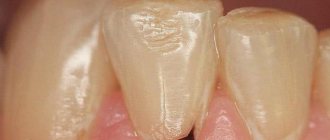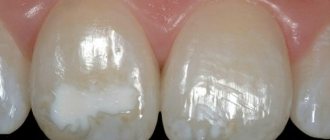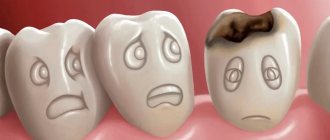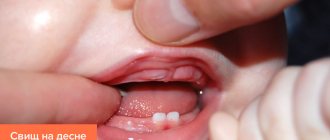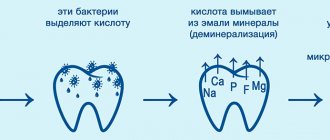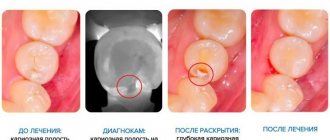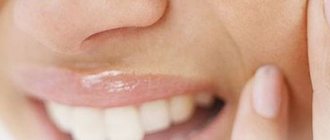Today we will discuss hidden caries, the reasons for its appearance, symptoms and forms of progression.
We will also dwell separately on the types of treatment for this disease. So, hidden caries is a pathological lesion of the enamel on the teeth, which a person without dental education will not be able to identify.
Most often it occurs in the interdental space, where food debris gets trapped. Due to the inaccessibility of such areas, the development of bacteria there occurs at an accelerated pace.
Let's take a closer look at those places that can potentially attract a large number of pathogenic microorganisms and provoke the occurrence of caries.
Favorite places where caries bacteria “hide”
Regarding the place of formation, latent caries can be of the following types:
- Contact. Occurs in the interdental space. It is often noticed when the entire tooth is affected, which causes severe pain. The cause is usually the constant presence of pieces of food in the interdental space. The treatment of such caries is quite unpleasant.
- Fissure. Formed in natural tooth cavities (fissures). It looks like a small dark spot on the tooth enamel. If such a stain is detected, it is important to immediately contact the dentist so as not to cause the disease to develop, because it progresses very quickly. Otherwise, the enamel in the darkened area will chip off, and the tooth will hurt greatly. This type of disease is quite easy to treat.
- Dental root caries. This is the most problematic and dangerous type of disease. It is most often determined when not only the root, but also the entire tooth is severely affected. Typically, such caries occurs in parallel with periodontitis. The tooth root is gradually separated from the gums and, exposed, is gradually destroyed. Sometimes there is no point in treating such a disease. Most often it is necessary to remove the affected dental organ.
- Secondary. Such caries develops under a filling. The cause of this disease is the penetration of bacteria under the filling during filling. It is determined when the filling falls out (if the affected cavity has grown greatly), or when the tooth begins to hurt. At the initial stage, the diagnosis can be made during a routine examination.
The danger of hidden caries lies in the fact that it is often noticed when the dental nerve is damaged and has to be removed.
Treatment of hidden caries
Many people wonder how this disease is treated?
Hidden caries is amenable to the same therapeutic methods as its usual form.
Modern dentistry operates with a conservative method of treatment without preparation and with preliminary drilling of the hard tissues of the diseased tooth.
The first method is used if caries is at an initial stage, if the color of the enamel changes, or if the patient, due to the characteristics of the body, cannot tolerate anesthesia (due to allegra to some components of painkillers), and treatment without it is impossible.
The non-invasive method involves mineralization of the enamel and removal of plaque that has formed due to caries. If you only have one tooth affected, the treatment procedure may take about an hour.
With high-quality therapeutic intervention, the disease will recede and additional manipulations will not be required in the future.
- The impact on a diseased tooth with preparation has several stages:
- Selection of the necessary medications and pain relief for the affected area.
- Treatment of the tooth and adjacent tissues using special means and mechanical means.
- Installing a protective lining.
- Filling damaged areas, holes and cracks that have formed.
- Grinding and polishing of the restored tooth.
Do not forget that hidden caries is treated better than the medium and deep forms of this pathology.
Therapy using preparation is resorted to only when the roots or nerves of the teeth begin to be damaged; in all other cases, they make do with mineralization and cleansing of the damaged part of the tooth.
One of the most progressive and new methods of treating this disease is the chemical-mechanical method. It involves applying special preparations to the affected part, then removing the diseased part of the tooth and filling it.
The advantages of the method are painlessness and the formation of a smaller cavity (compared to invasive intervention), which requires filling. The affected tissue can also be removed with a powerful stream of air, water and special powder, which eliminates damage to the healthy part of the tooth.
But this method is effective only in the initial stages of the disease, when hidden caries has just begun to form.
The laser is also well applicable for this disease; it is able to perfectly identify the area affected by caries and neutralize it. All these methods are good because they are less painful than treatment with a drill, and sometimes do not cause any discomfort at all.
But such procedures will cost the patient somewhat more than classical treatment, and not every clinic has the appropriate equipment for advanced therapy.
What causes the disease?
Hidden caries can be caused by various reasons. Let's consider the main ones:
- poor oral hygiene;
- abuse of sweets;
- presence of gastrointestinal diseases;
- insufficient amount of vitamins in the body;
- weakened immune system;
- improper formation of dental organs;
- lack of calcium, fluorine and phosphorus in drinking water.
The listed factors lead to the proliferation of pathogenic bacteria in the oral cavity, which leads to the formation of hidden cavities from caries.
Causes of caries development
Hidden caries is a caries that cannot be noticed without special tools or x-rays. This is a fairly common disease characterized by demineralization of enamel and destruction of hard tissue under the influence of pathogenic bacteria. The risk of developing cavities increases:
- in case of violation of the rules of oral hygiene,
- using the wrong toothbrush and toothpaste,
- lack of calcium, phosphorus, fluorine and vitamin D in the body,
- unbalanced diet and smoking,
- excessive consumption of sweets and drinks high in sugar.
Caries also actively develops with weak immunity. A strong immune system is able to suppress pathogenic microorganisms.
The danger of a latent form of the disease
The fact that latent caries occurs without symptoms is the main problem for its treatment. After all, if it is not identified, treatment will not be started, and the disease will progress, leading to unpleasant consequences.
Most often, this form of caries turns into pulpitis, which manifests itself in damage to the pulp. In this case, the dental nerve is removed. Pulpitis can also turn into periodontitis when the gums of a diseased tooth are affected. In this case, the tooth can often be lost.
The disease can also easily spread to other teeth. Caries, of course, is not contagious, but due to poor cleaning of the interdental space between the affected and healthy teeth from pieces of food, caries occurs on the latter.
Also, the tooth can be destroyed by caries inside the crown, and simply crumble under stress. The problem is that in this case there are no symptoms of caries.
Dental caries is...
Dental caries (lat. caries dentis) is a complex, slow-moving pathological process that occurs in the hard tissues of the tooth (dentin with a cavity, covered on the outside with enamel and cement). Dentin (lat. dentinum) is the hard tissue of the tooth, making up its bulk in the area of the crown, neck and root. The coronal part is covered with enamel, the root part of the dentin is covered with cement. Dentin in its structure is a crystallized material that contains 70% inorganic substances, 20% organic substances and 10% water.
Signs and characteristics of the disease
The main danger of hidden caries is that in the first stages it does not manifest itself in any way. There is no pain or external manifestations that the patient could detect. The manifestation occurs when the tooth or its root is already significantly damaged.
If a filling falls out in a tooth, this is the first signal about the presence of a hidden secondary illness. This indicates that the caries cavity under the filling has greatly expanded. In this case, light and dark spots may appear on the enamel.
If the damage is already extensive, the tooth becomes sensitive to cold, hot, salty and sweet foods. At the same time, painful sensations do not appear on their own, they are provoked only by irritants, and when they are excluded, they stop.
Voluntary pain already indicates the transition of the disease to pulpitis when the nerve bundle of the tooth is affected. Mechanical impact (during chewing) on the tooth also causes pain. The pain gradually intensifies and becomes sharp, which not every patient can tolerate. In this case, the pulp will most likely have to be removed and the canals filled.
Features of hidden caries:
- The destruction of the dental organ from the inside occurs; external signs are usually not detected.
- Applies to both chewing and anterior dental organs. In the smile area, it most often occurs in the interdental spaces. On chewing teeth it usually forms in natural depressions (fissures).
- On the front teeth, the disease progresses quickly and affects the pulp, since it is located close to the surface. When removed, the tooth may darken and become brittle, which can contribute to its destruction.
- Affecting the fissures of chewing teeth, the disease usually manifests itself as a small dark spot on the enamel, under which significant destruction is often found.
- If hidden caries could not be diagnosed during a routine examination, but there is still a suspicion of it, X-rays or transluminescence are used. On an x-ray, you can see translucent caries cavities, and with the help of transluminescence, the tooth is illuminated, making the areas affected by caries visible in the form of dark spots.
Symptoms and course of the disease
Hidden caries does not appear in the initial stages of the disease and becomes noticeable only after serious damage to the dental tissue. There is no pain, dental lesions are not visible in the mirror. Now, if a filling falls out, this is already an important symptom, meaning that caries is developing. The enamel becomes spotted.
If caries has progressed far, the tooth begins to hurt severely due to temperature changes, from sweet or salty foods. At the same time, the tooth itself does not hurt, only from various causes. When the irritant disappears, the pain immediately goes away. If pain begins to appear on its own, it means that caries has already turned into pulpitis, and the tooth tissue has begun to become inflamed.
If you press on the affected area (chewing food), it also responds with pain. The reason for this is that food penetrates the hole and compresses the vessels and nerves of the pulp. If the remaining food is removed from the affected area, the pain will go away.
How is the disease determined?
Thanks to new diagnostic methods, it is not difficult to identify hidden caries in dentistry. Where the outbreak formed and how advanced the disease is is unimportant.
But before applying these methods, the dentist needs to identify the presence of a carious process, which is not always possible, because the tooth looks healthy and the patient does not complain about it. Therefore, caries often goes unnoticed and gradually develops.
Often there is a joint course of latent caries with another carious process, which is easy to identify by visual examination. If the patient has a large number of injuries, a good specialist will carefully check all dental organs for the presence of hidden carious formations. To do this, use the following diagnostic methods:
- Laser. This is a very reliable method, which is performed using a device called “Diagnodent”. This device detects a lesion by reflecting a laser beam from the affected area, creating a characteristic sound.
- Radiography. Hidden caries can be seen on an x-ray, but only in cases where it has already developed significantly.
- Visual inspection using a mirror and dental instruments. This method is used initially. So, the probability of a carious lesion is determined, which is then checked, if necessary, by other methods.
- Transillumination involves the use of a photopolymerization lamp, the light from which is directed onto the tooth, and when caries is detected in it, dark spots become noticeable.
Due to the impossibility of diagnosing latent caries on your own, it is important to make regular visits to the dentist for preventive examinations.
Basic diagnostic methods
The most common methods for detecting such a disease as hidden caries include:
- The simplest method is the well-known classic mirror inspection.
- Laser method. It is considered very progressive and accurate. Even during the initial onset of hidden caries, he will be able to identify it.
- The X-ray method detects pathology in hard-to-reach places at a late stage of development. To carry it out, it is enough to take an x-ray, which will show the part of the tooth affected by the disease.
- Transillumination using a photopolymerization lamp. This method can give a complete picture of the affected areas with hidden caries.
How to treat a hidden disease?
Hidden caries is treated in the same way as regular caries, that is, the affected tissue is removed and a filling is placed. If a stain is found on the enamel or it is damaged, the dental tissue is opened. The enamel is restored with preparations containing calcium and fluoride.
When a pathogenic process develops under the filling, it is removed, after which the tooth is cleaned. Then the filling is placed again. The procedure is performed under anesthesia.
Note: If the tooth is severely damaged, after removing all the tissues affected by caries, a crown is installed on it, and for less significant damage, a dental inlay can be used.
If the cervical part of the tooth is damaged, in addition to standard procedures, correction of nearby soft tissues is performed.
If the inflammatory process has affected the dental nerve, it is necessary to remove the pulp. And sometimes, at an advanced stage of pulpitis, the tooth has to be removed altogether. In this case, after the gums have healed, a prosthesis on an implant or a bridge can be installed in its place.
How is caries treated?
The treatment method for caries depends on its stage. At the very beginning of the development of pathology, the enamel is remineralized by saturating it with microelements. A fluoride solution is applied to the tooth to strengthen the tooth surface. For children, medications with a fluoride concentration of no more than 500 ppm are selected. At home, they can use toothpastes designed to prevent caries: Splat Kids, ROCS Kids, Weleda with calendula, Levrana “Orange” or Theodent Kids.
If a carious cavity has formed and caries has penetrated into the dentin, the tooth must be prepared and filled. Treatment can be carried out both under anesthesia and without anesthesia. If the pathology has spread to the pulp, it is removed and then a filling is placed. Filling is carried out according to the following algorithm:
- cleaning the carious cavity from necrotic tissue;
- disinfection of the tooth surface with an antibacterial agent;
- installation and drying of the protective gasket;
- application of composite material;
- grinding and polishing the filling after hardening.
The filling should not prevent a person from chewing food and brushing his teeth. If it is installed incorrectly, secondary caries may develop. After treatment, it is necessary to engage in prevention.
Possible consequences
A disease such as caries can lead to the following consequences:
- allergic reaction to infection;
- inflammation of the gums and facial tissues;
- the negative impact of a diseased tooth on the patient’s entire body;
- flux;
- jaw cyst;
- problems with the gastrointestinal tract as a result of poor chewing of food due to severe pain;
- the need to remove a tooth as a result of the patient’s untimely visit to the dentist, which represents a lot of stress for the whole body;
- pulpitis and periodontitis, which can also become chronic.
The main danger of hidden caries lies in its invisibility, and therefore in untimely treatment. This disease can easily pass from one tooth to another.
What complications can caries have?
If caries is not treated, its consequences can be not only serious dental diseases:
- pulpitis,
- periodontitis,
- cyst/granuloma,
- abscess/phlegmon,
as a result of which you can easily lose a tooth, but also general diseases of the whole body :
- gastrointestinal diseases, in particular gastritis and stomach ulcers,
- cardiovascular diseases, including infectious myocarditis,
- inflammatory joint diseases,
- allergic reactions.
Prevention
To prevent hidden caries, it is important to follow the following recommendations from dentists:
- Clean your mouth twice a day, paying special attention to the spaces between teeth and hard-to-reach places. It is important to choose the most suitable toothbrush, toothpaste and floss.
- For daily drinking, use water with sufficient fluoride. After all, the lack of this substance leads to the destruction of tooth enamel. To do this, you can fluoridate the water, or eat enough seafood. Another effective method is rinsing the mouth with special liquids.
- Eat food that is not too cold and not too hot. Otherwise, small cracks in the enamel are possible, where pathogenic bacteria can easily enter.
- Go to the dental clinic at least once every six months for adults and twice every six months for children.
- If plaque accumulates on the tooth enamel, you need to have it professionally cleaned.
- Eat so that the body is saturated with all the necessary vitamins and minerals.
How to recognize the problem
Hidden caries is very similar in the course of the disease to its usual form. The severity of destruction of enamel and dentin tissue depends on the degree of damage to a particular area of the dentition.
Most often, caries is hidden in the following areas:
- spaces between teeth, especially on the inside of the mouth;
- in the area of loose fit of a filling or crown;
- the subgingival part of the tooth, where food debris accumulates in the periodontal sacs and this causes the development of pathogenic microorganisms;
- in fissures.
The root cause of late diagnosis is the inaccessibility of the listed areas for both teeth cleaning and diagnostics. Once an advanced form of caries is detected, treatment is quite complex and lengthy, and sometimes even requires extraction of the unit.
Important! Hidden caries can very quickly move to neighboring teeth and affect their surface.
Questions
Question
— My hidden caries was not discovered until the tooth began to hurt. Although I visit a professional specialist regularly. As a result, the tooth was severely crumbled, and I had to put a crown on it.
Answer
— The reasons for this situation may be different. Either the dental canals were poorly treated, or hidden caries developed on the adjacent tooth, or the part where the adjacent teeth touch each other was poorly formed, which injures the gums. It is important to find out the cause of the pain in order to avoid periodontitis of the tooth you treated or caries (and possibly pulpitis) of the neighboring tooth.
Question
— My tooth began to hurt, in which caries was treated 4 years ago. The filling was replaced and a new one was installed. Now it hurts again for two weeks. What to do?
Answer
- You should consult your doctor. The tooth may hurt after the procedure, which will gradually go away, but other situations are also possible, which will most likely have to be identified through x-rays.
Memo for patients during the treatment of caries.
- Do not drink alcohol before your appointment - this will reduce the effect of anesthesia.
- After the appointment, until the anesthesia wears off, you should not talk much - you can injure the numb tissue.
- You should not eat food within 2 hours after treatment, especially hot food for the same reason.
- After taking it, increased sensitivity may persist for several days, and bleeding gums may occur.
- If after taking it you feel discomfort when biting or pain, consult a doctor immediately.
Secondary caries
Such caries develops next to or under a previously installed filling. In this case, it is called secondary.
“It’s been standing for 10 years, it’ll stand for the same amount of time,” is the most common mistake made by patients.
Any filling has a service life: over time, its marginal seal is disrupted, and caries begins. Under the filling, the carious cavity is not visible, and while there is no pain, nothing indicates pathological processes inside. Such a tooth is a real “time bomb”.
Contact caries
The situation is much worse with contact caries, which is hidden between the teeth - it is even more difficult to see. However, there are signs by which you can suspect it in yourself: darkening of the enamel, constant sticking of food, dental floss fibers, as well as a short-term painful reaction to sweets. If you have noticed at least one of these manifestations, it’s time to get examined! The sooner you see a doctor, the more favorable the prognosis will be.
Classification of caries.
The difference in “zones” of damage to hard dental tissues by caries allows us to classify the disease according to this principle. Enamel (enamel caries), dentin (dentine caries), and cement (tooth root cement caries) are susceptible to damage. The severity of the disease is the next point in the classification.
Caries is distinguished:
- in the spot stage;
- superficial caries;
- medium and deep caries.
Let's take a closer look.
Caries in the stain stage – (lat. macula cariosa) is the so-called “demineralization” of teeth. The enamel becomes rough, losing its natural shine. Matte white or light or dark brown spots appear on it. Such caries is usually asymptomatic (as a rule, there is no painful reaction of the teeth to external irritants). With further “violation” of the integrity of the surface layer (progressive demineralization) of the teeth, the stain turns into superficial caries. caries in the spot stage
Superficial caries (lat. caries superficialis) and medium (lat. caries media) dental caries. When examining a tooth, a carious cavity is discovered, which is located within the enamel (superficial), and when dentin is involved in the destruction process, we are talking about a moderate degree of severity. These stages of disease development are characterized by the occurrence of short-term pain from external irritants (hot-cold; sweet, sour, salty) and bad breath. superficial caries damage to dentin
Deep (lat. caries profunda) dental caries is more significant destruction. Upon examination, a deep carious cavity filled with softened dentin is discovered. Painful sensations from external stimuli may last longer. Probing the bottom of the cavity is very painful. deep caries
How does cervical caries develop?
The beginning of cervical caries is the accumulation of plaque near the neck of the tooth.
Against the background of increased acidity and lack of oxygen, as well as under the action of enzymes secreted by bacteria, the enamel softens, opening the gates of infection.
The basal form of caries develops in 4 stages:
- in the first, known as the white spot stage, a dull white spot appears on the tooth at the level of the gum margin;
- at the second stage, a superficial carious lesion develops, which looks like darkening of the enamel;
- on the third, the carious cavity deepens through the enamel into the thickness of the dentin;
- at the fourth stage, deep caries develops, and a “hollow” forms in place of the spot.
The final stage of the disease is a fracture of the tooth in the neck area, pulpitis, accompanied by acute pain, and sometimes an abscess in the gum.
Establishing diagnosis
Diagnostic techniques of modern dentists make it possible to identify hidden caries at all its stages and at any location. The difficulty is that such methods are used, as a rule, only if there is a suspicion of the development of the disease. Only an experienced dentist can notice indirect signs of a carious process and prescribe additional diagnostics, even if the patient has no symptoms. Often, the likelihood of hidden caries is indicated by the general condition of the patient's oral cavity. If there are multiple manifestations of the carious process on other teeth, the doctor may decide to conduct a more thorough examination of teeth that appear healthy in appearance. In such cases, the following diagnostic methods are prescribed:
- Luminescent diagnostics and transillumination.
- Laser examination.
- X-ray.
Diagnosing hidden caries at home is almost impossible until it has developed to a deep stage. Therefore, it is so important not to miss annual preventive examinations at the dental clinic, where an experienced doctor, using modern means, is able to detect the disease without waiting for complications to develop.


